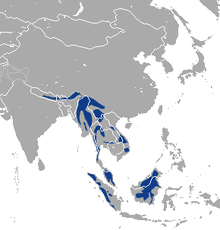
Felidae is the family of mammals in the order Carnivora colloquially referred to as cats. A member of this family is also called a felid. The term "cat" refers both to felids in general and specifically to the domestic cat.
Panthera is a genus within the family Felidae that was named and described by Lorenz Oken in 1816 who placed all the spotted cats in this group. Reginald Innes Pocock revised the classification of this genus in 1916 as comprising the tiger, lion, jaguar, and leopard on the basis of common cranial features. Results of genetic analysis indicate that the snow leopard also belongs to the genus Panthera, a classification that was accepted by IUCN Red List assessors in 2008.

Felis is a genus of small and medium-sized cat species native to most of Africa and south of 60° latitude in Europe and Asia to Indochina. The genus includes the domestic cat. The smallest Felis species is the black-footed cat with a head and body length from 38 to 42 cm. The largest is the jungle cat with a head and body length from 62 to 76 cm.

Neofelis is a genus comprising two extant cat species in Southeast Asia: the clouded leopard of mainland Asia, and the Sunda clouded leopard of Sumatra and Borneo.
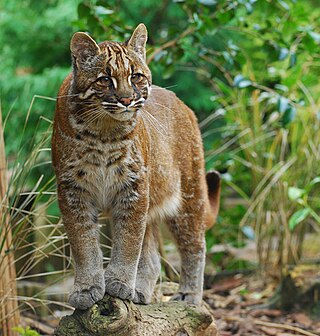
The Asian golden cat is a medium-sized wild cat native to the northeastern Indian subcontinent, Southeast Asia and China. It has been listed as Near Threatened on the IUCN Red List since 2008, and is threatened by poaching and habitat destruction, since Southeast Asian forests are undergoing the world's fastest regional deforestation.

The bay cat, also known as the Bornean bay cat, is a small wild cat endemic to the island of Borneo that appears to be relatively rare compared to sympatric wild cats, based on the paucity of historical, as well as recent records. Since 2002, it has been listed as Endangered on the IUCN Red List because it is estimated that fewer than 2,500 mature individuals exist, and that the population declined in the past. The bay cat has been recorded as rare and seems to occur at relatively low density, even in pristine habitat.

The African golden cat is a wild cat endemic to the rainforests of West and Central Africa. It is threatened due to deforestation and bushmeat hunting and listed as Vulnerable on the IUCN Red List. It is a close relative of both the caracal and the serval. Previously, it was placed in the genus Profelis. Its body size ranges from 61 to 101 cm with a 16 to 46 cm long tail.

Catopuma is a genus of felid containing two small wild cat species, the Asian golden cat and the bay cat. Together with the genus Pardofelis it forms the bay cat lineage of felines. Both are typically reddish brown in colour, with darker markings on the head.

The flat-headed cat is a small wild cat with short reddish-brown fur. Its head is elongated, and its ears are rounded. Its slender body is 41 to 50 cm long with a tail of 13 to 15 cm, and it weighs 1.5 to 2.5 kg.
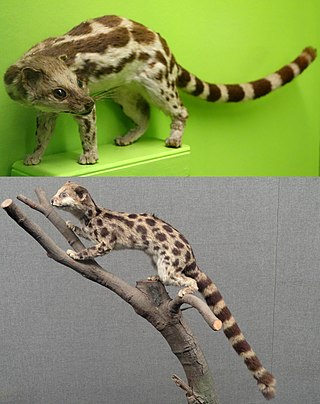
The Asiatic linsang (Prionodon) is a genus comprising two species native to Southeast Asia: the banded linsang and the spotted linsang. Prionodon is considered a sister taxon of the Felidae.

Prionailurus is a genus of spotted, small wild cats native to Asia. Forests are their preferred habitat; they feed on small mammals, reptiles and birds, and occasionally aquatic wildlife.
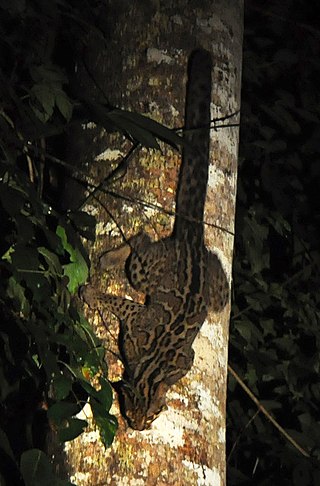
The marbled cat is a small wild cat native from the eastern Himalayas to Southeast Asia, where it inhabits forests up to an elevation of 2,500 m (8,200 ft). As it is present in a large range, it has been listed as Near Threatened on the IUCN Red List since 2015.

Reginald Innes Pocock F.R.S. was a British zoologist.
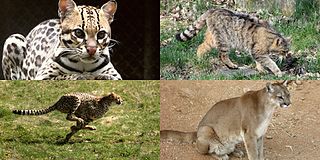
The Felinae are a subfamily of the family Felidae. This subfamily comprises the small cats having a bony hyoid, because of which they are able to purr but not roar.

Leopardus is a genus comprising eight species of small cats native to the Americas. This genus is considered the oldest branch of a genetic lineage of small cats in the Americas whose common ancestor crossed the Bering land bridge from Asia to North America in the late Miocene.

Pantherinae is a subfamily within the family Felidae; it was named and first described by Reginald Innes Pocock in 1917 as only including the Panthera species. The Pantherinae genetically diverged from a common ancestor between 9.32 to 4.47 million years ago and 10.67 to 3.76 million years ago.

The Sunda clouded leopard is a medium-sized wild cat native to Borneo and Sumatra. It is listed as Vulnerable on the IUCN Red List since 2015, as the total effective population probably consists of fewer than 10,000 mature individuals, with a decreasing population trend. On both Sunda Islands, it is threatened by deforestation. It was classified as a separate species, distinct from the clouded leopard in mainland Southeast Asia based on a study in 2006. Its fur is darker with a smaller cloud pattern.
Htamanthi Wildlife Sanctuary is a 2,150.73 km2 (830.40 sq mi) large protected area in northern Myanmar. It was established in 1974 in the Sagaing Region.
Hponkanrazi Wildlife Sanctuary is a protected area in northern Myanmar, stretching over an area of 2,703.95 km2 (1,044.00 sq mi). It was established in 2003. It encompasses riverine habitats, subtropical moist forest, temperate forest, deciduous forest and alpine forest. It is contiguous with Hkakaborazi National Park, Bumhpa Bum Wildlife Sanctuary and Hukaung Valley Wildlife Sanctuary. Together, they form a 30,269 km2 (11,687 sq mi) large protected area complex of natural forest called the Northern Forest Complex. It is managed by the Forest Department.

